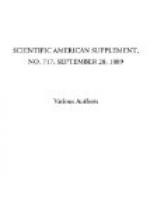Lender’s process is very useful when ozone is wanted on a limited scale. We have some of it here prepared by Mr. Rossiter, and it answers exceedingly well; but it would be impossible to generate sufficient ozone by this plan for the large application that would be required should it come into general use. The process deserves to be remembered, and the physician may find it valuable as a means by which ozone may be medically applied, to wounds, or by inhalation when there are foetid exhalations from the mouth or nostrils.
A NEW METHOD.
For the past ten or fifteen years the manufacture of ozone, for the reasons related above, has remained in abeyance, and it is to a new mode, which will, I trust, mark another stage of advancement, that I now wish to direct attention. Some years since, Mr. Wimshurst, a most able electrician, invented the electrical machine which goes by his name. The machine, as will be seen from the specimen of it on the table, looks something like the old electrical machine, but differs in that there is no friction, and that the plates of glass with their metal sectors, separated a little distance from each other, revolve, when the handle of the machine is turned, in opposite directions. The machine when it is in good working order (and it is very easily kept in good working order) produces electricity abundantly, and in working it I observed that ozone was so freely generated, that more than once the air of my laboratory became charged with ozone to an oppressive degree. The fact led me to use this machine for the production of ozone on a large scale, in the following way.
From the terminals of the machine two wires are carried and are conducted, by their terminals, to an ozone generator formed somewhat after the manner of Siemens’, but with this difference, that the discharge is made through a series of fine points within the cylinders. The machine is placed on a table with the ozone generator at the back of it, and can be so arranged that with the turning of the handle which works the machine a blast of air is carried through the generator. Thus by one action electricity is generated, sparks are discharged in the ozone generator, air is driven through, and ozone is delivered over freely.
If it be wished to use pure oxygen instead of common air, nothing more is required than to use compressed oxygen and to allow a gentle current to pass through the ozone generator in place of air. For this purpose Brin’s compressed oxygen is the purest and best; but for ordinary service atmospheric air is sufficient.[2]
[Footnote 2: For illustration to-day, Messrs Mayfield, the electrical engineers of Queen Victoria Street, E. C., have been good enough to lend me a machine fitted up on the plan named. It works so effectively that I can make the ozone given off from it detectable in every part of this large hall.]
The advantages of this apparatus are as follows:




